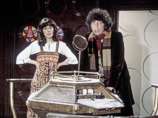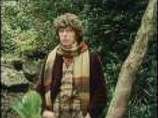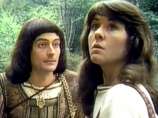 |
|
Sarah and The Doctor
|
|
 While The Doctor and his travelling companion Sarah Jane Smith are investigating some unfamiliar areas of the TARDIS they come across another Console Room with wood panelling and a smaller central control console. The Doctor tells Sarah that this is the TARDIS’ secondary control room. While The Doctor and his travelling companion Sarah Jane Smith are investigating some unfamiliar areas of the TARDIS they come across another Console Room with wood panelling and a smaller central control console. The Doctor tells Sarah that this is the TARDIS’ secondary control room.
 Switching on the scanner, The Doctor realises that they are very close to a Mandragora Helix, a spiral of energy radiating outwards with a controlling influence at the centre. Before The Doctor can do anything the TARDIS is captured by the Helix and is drawn to a still point at its centre. After a brief look outside, The Doctor dematerialises the TARDIS, but unnoticed a sparkling piece of Mandragora energy enters the TARDIS. It then emerges, again unseen, from the TARDIS at the next point of call, Earth… Switching on the scanner, The Doctor realises that they are very close to a Mandragora Helix, a spiral of energy radiating outwards with a controlling influence at the centre. Before The Doctor can do anything the TARDIS is captured by the Helix and is drawn to a still point at its centre. After a brief look outside, The Doctor dematerialises the TARDIS, but unnoticed a sparkling piece of Mandragora energy enters the TARDIS. It then emerges, again unseen, from the TARDIS at the next point of call, Earth…
 The TARDIS has materialised in a field in the Dukedom of San Martino, in fifteenth century Renaissance Italy. As they start to explore Sarah wanders off and is kidnapped by a group of men in hooded robes. The Doctor tries to rescue her but is knocked unconscious. When he awakes he is shocked to witnesses an energy fragment fly towards a peasant – who is then killed. The Doctor realises that the Mandragora energy, has hitched a lift in his TARDIS and is now on the loose and up to no good. While searching for Sarah, The Doctor is soon confronted by some guards and arrested. The TARDIS has materialised in a field in the Dukedom of San Martino, in fifteenth century Renaissance Italy. As they start to explore Sarah wanders off and is kidnapped by a group of men in hooded robes. The Doctor tries to rescue her but is knocked unconscious. When he awakes he is shocked to witnesses an energy fragment fly towards a peasant – who is then killed. The Doctor realises that the Mandragora energy, has hitched a lift in his TARDIS and is now on the loose and up to no good. While searching for Sarah, The Doctor is soon confronted by some guards and arrested.
 | | The Doctor |
|
 The Doctor finds himself taken to the court of Count Federico. The Doctor tries to warn the Count about the energy fragment, that killed the peasant and the danger it poses to the whole of mankind, but Count Federico does not believe him and orders The Doctor to be executed as a spy. The Doctor is then led to an executioner and is forced to his knees for decapitation. However, before the executioner can use his sword, The Doctor manages to unfurl his scarf and hook it around the executioner's ankle, throwing him off balance. The Doctor then escapes out of the palace grounds and finds his way into some catacombs beneath the city. The Doctor finds himself taken to the court of Count Federico. The Doctor tries to warn the Count about the energy fragment, that killed the peasant and the danger it poses to the whole of mankind, but Count Federico does not believe him and orders The Doctor to be executed as a spy. The Doctor is then led to an executioner and is forced to his knees for decapitation. However, before the executioner can use his sword, The Doctor manages to unfurl his scarf and hook it around the executioner's ankle, throwing him off balance. The Doctor then escapes out of the palace grounds and finds his way into some catacombs beneath the city.
 These are the same catacombs that Sarah has been taken to. This is where the outlawed star worshipping Brotherhood of Demnos, the Roman god of moonlight and solstice, gather. Sarah is brought before a priest and is told that she is the foretold sacrifice to Demnos. She is then dressed in a white robe and made ready to be sacrificed. These are the same catacombs that Sarah has been taken to. This is where the outlawed star worshipping Brotherhood of Demnos, the Roman god of moonlight and solstice, gather. Sarah is brought before a priest and is told that she is the foretold sacrifice to Demnos. She is then dressed in a white robe and made ready to be sacrificed.
 | | Sarah Jane Smith |
|
 As Sarah is about to be sacrificed on a stone alter The Doctor arrives to rescue her. At the same time the Mandragora energy also enters the underground temple. Its arrival distracts the worshippers so allowing The Doctor to rescue Sarah. The worshippers, led by the court astrologer Hieronymous, are awed by the presence of the Mandragora energy and Hieronymous receives instructions to make ready for Mandragora's full appearance. As Sarah is about to be sacrificed on a stone alter The Doctor arrives to rescue her. At the same time the Mandragora energy also enters the underground temple. Its arrival distracts the worshippers so allowing The Doctor to rescue Sarah. The worshippers, led by the court astrologer Hieronymous, are awed by the presence of the Mandragora energy and Hieronymous receives instructions to make ready for Mandragora's full appearance.
 Hieronymous, however, is one of the pawns in the evil Count Federico's plans to take control of the Dukedom of San Martino for himself. He intends to usurp his young nephew Giuliano, whose recent accession to the Dukedom is being marked with a celebratory masque. Count Federico had already arranged for the old Duke to die under 'mysterious circumstances', as predicted by the stars, and is planning for the same to happen to the new Duke, Giuliano. Hieronymous, who is increasingly coming under the influence of Mandragora, realises that The Doctor is a threat and so arranges for the Brethren of Demnos to capture Sarah again. He then hypnotises Sarah and instructs her to kill The Doctor. Hieronymous, however, is one of the pawns in the evil Count Federico's plans to take control of the Dukedom of San Martino for himself. He intends to usurp his young nephew Giuliano, whose recent accession to the Dukedom is being marked with a celebratory masque. Count Federico had already arranged for the old Duke to die under 'mysterious circumstances', as predicted by the stars, and is planning for the same to happen to the new Duke, Giuliano. Hieronymous, who is increasingly coming under the influence of Mandragora, realises that The Doctor is a threat and so arranges for the Brethren of Demnos to capture Sarah again. He then hypnotises Sarah and instructs her to kill The Doctor.
 The Doctor however, becomes aware of the trap when Sarah innocently asks him how she is able to speak and understand the local language - something that had not previously bothered her in all the times and places she had visited while with The Doctor. He de-hypnotises her and then makes arrangements to remove Mandragora's influence from Earth. The Doctor however, becomes aware of the trap when Sarah innocently asks him how she is able to speak and understand the local language - something that had not previously bothered her in all the times and places she had visited while with The Doctor. He de-hypnotises her and then makes arrangements to remove Mandragora's influence from Earth.
 | | Sarah and Count Federico |
|
 The Doctor has deduced that the Helix used the TARDIS to arrive at this crucial point of transition between the Dark Ages and the dawn of the Renaissance. Also in San Martino the Brethren provided a ready-made power base that it could use. The Doctor, after doing some astronomical observations, calculates there will be a lunar eclipse that evening and it is at this point that the Mandragora Helix will take over the Earth by removing all sense of purpose from mankind. Right now, however, he realises that the Mandragora Helix energy is currently spread thinly over all the Brethren, and so could be exhausted. The Doctor has deduced that the Helix used the TARDIS to arrive at this crucial point of transition between the Dark Ages and the dawn of the Renaissance. Also in San Martino the Brethren provided a ready-made power base that it could use. The Doctor, after doing some astronomical observations, calculates there will be a lunar eclipse that evening and it is at this point that the Mandragora Helix will take over the Earth by removing all sense of purpose from mankind. Right now, however, he realises that the Mandragora Helix energy is currently spread thinly over all the Brethren, and so could be exhausted.
 At the height of the masked ball, the Brethren of Demnos attack the court and kill many of the guests with bolts of fire. Meanwhile Hieronymous, who has now been completely taken over by Mandragora, confronts The Doctor in the underground temple and attempts to blast him down. The Doctor however, has earthed both himself and the altar so that the Mandragora energy blasts are carried safely away. At the height of the masked ball, the Brethren of Demnos attack the court and kill many of the guests with bolts of fire. Meanwhile Hieronymous, who has now been completely taken over by Mandragora, confronts The Doctor in the underground temple and attempts to blast him down. The Doctor however, has earthed both himself and the altar so that the Mandragora energy blasts are carried safely away.
 Disguised as Hieronymous, The Doctor then lures the Brethren back down into the temple. They arrive just as the eclipse of the moon occurs. As the Brethren place their hands on the altar the ball of Helix energy then descends and all the members of the Brethren are consumed by the Helix energy which then drains away, leaving the planet safe. Disguised as Hieronymous, The Doctor then lures the Brethren back down into the temple. They arrive just as the eclipse of the moon occurs. As the Brethren place their hands on the altar the ball of Helix energy then descends and all the members of the Brethren are consumed by the Helix energy which then drains away, leaving the planet safe.
 As they prepare to leave, in the TARDIS, The Doctor tells Sarah that even though they have prevented the Mandragora Helix doing any long lasting damage the Mandragora's constellation will be in a position for it to make a further attack on the Earth in about five hundred years' time - at the end of the Twentieth Century. As they prepare to leave, in the TARDIS, The Doctor tells Sarah that even though they have prevented the Mandragora Helix doing any long lasting damage the Mandragora's constellation will be in a position for it to make a further attack on the Earth in about five hundred years' time - at the end of the Twentieth Century.
|